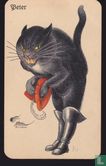- Catalogue manager
- 5,354 messages
- January 26, 2024 18:08
Is adapted.
- 1,552 messages
- January 26, 2024 16:43
LastDodo Naturalia catalogus
LastDodo Naturalia catalogue
- Catalogue administrator
- 6 messages
- January 14, 2024 13:51
Ik begrijp de vraag. Mijn antwoord kan complex zijn, maar ik beperk me tot een aantal punten:
- Het laagste niveau van beschrijving bij schelpen is niet soort, maar ondersoort. Het beschrijvingsmodel dat wij in Last Dodo hanteren bij Naturalia bevat dit niveau.
- Er moet verschil gemaakt worden tussen niet perfect gelijk uitziende exemplaren van een soort (= variatie in exemplaren) en officiële ondersoorten.
- Officiële ondersoorten (subspecies) zijn wetenschappelijk als zodanig beschreven en hebben een drieledige latijnse naam (bijv. Amphidromus perversus borneensis) Dit soort ondersoorten neem ik op naast de 'oer'soort zijnde Amphidromus perversus (perversus). Bij sommige soorten landslakken zoals Amphidromus perversus en Liguus fasciatus kennen we wel 100 officiële ondersoorten. Zulke ondersoorten komen veelal in geografisch van elkaar gescheiden gebieden (niches) voor. Het is logisch dat dit vooral voorkomt bij landslakken, die zich in tegenstelling tot zeeslakken over veel beperktere gebieden kunnen verspreiden.
- Verzamelaars verzamelen veelal tot op het niveau van ondersoorten. Ze gooien soorten en ondersoorten niet op een hoop. LAST DODO is primair een site voor verzamelaars!
- Belangrijke veilingsites (zie Shellauction.net) bieden ondersoorten afzonderlijk aan! Er zijn vaak grote prijsverschillen tussen ondersoorten. (Op basis van zeldzaamheid).
- In andere catalogi (op last dodo) tref je vergelijkbare problemen aan. Bij postzegels bijv vinden we aparte items voor volstrekt gelijk uitziende zegels, op grond van het feit dat ze al dan niet zelfklevend zijn, of anders gesneden zijn etc. In catalogi (bijv. Michel) hebben die verschillende nummers. Last Dodo neemt die ook naast elkaar op.
Je kunt wat mij betreft dit antwoord ook doorgeven aan je collega die de vraag stelde. Ik begrijp dat iemand die dit verzamelgebied niet goed kent, en evenmin de internationale regels van taxonomie, tot deze vraag komt.
Groet,
Jan Delsing
I understand the question. My answer may be complex, but I will limit myself to a few points:
- The lowest level of description for shells is not species, but subspecies. The description model that we use in Last Dodo at Naturalia contains this level.
- A distinction must be made between specimens of a species that do not look exactly the same (= variation in specimens) and official subspecies.
- Official subspecies (subspecies) are scientifically described as such and have a three-part Latin name (e.g. Amphidromus perversus borneensis). I include this type of subspecies in addition to the 'original' species that is Amphidromus perversus (perversus). For some species of land snails such as Amphidromus perversus and Liguus fasciatus, we know as many as 100 official subspecies. Such subspecies often occur in geographically separated areas (niches). It makes sense that this mainly occurs in land snails, which, unlike sea snails, can disperse over much more limited areas.
- Collectors often collect down to subspecies level. They don't lump species and subspecies together. LAST DODO is primarily a site for collectors!
- Major auction sites (see Shellauction.net) offer subspecies separately! There are often large price differences between subspecies. (Based on rarity).
- You will find similar problems in other catalogs (at last dodo). With stamps, for example, we find separate items for completely identical-looking stamps, based on the fact that they are self-adhesive or not, or are cut differently, etc. In catalogs (e.g. Michel) they have different numbers. Last Dodo also records these side by side.
As far as I'm concerned, you can also pass this answer on to your colleague who asked the question. I understand that someone who does not know this collecting area well, nor the international rules of taxonomy, comes to this question.
Greeting,
Jan Delsing
- Catalogue manager
- 5,354 messages
- January 14, 2024 09:07
Via een pb van
Dat is bij de rubriek Naturalia natuurlijk een probleem, omdat deze items niet door mensen in serie gemaakt zijn. Elke schelp zal in details van elkaar verschillen. Om ze toch te kunnen determineren worden Naturalia ingedeeld in Klasse, Soort, Familie, Rijken, Orde, Stammen, etc.
Wat er niet moet gebeuren is dat in 1 item verschillende sub-soorten e.d. komen. Van elke determinatie op het laagste niveau wordt er 1 LD-item ingevoerd. Op de foto's daarvan, mogen wel meerdere schelpen van deze determinatie zijn afgebeeld.
Via a PM from
This is of course a problem with the Naturalia section, because these items are not made in series by people. Each shell will differ from each other in details. In order to be able to identify them, Naturalia are divided into Class, Species, Family, Kingdoms, Order, Tribes, etc.
What should not happen is that different sub-species, etc., are included in 1 item. For each determination at the lowest level, 1 LD item is entered. The photos may show several shells of this identification.
- Catalogue administrator
- 6 messages
- January 14, 2024 00:05
Twee dingetjes: Crassostrea gigas heet tegenwoordig officieel Magalana gigas. Dus daar vind je de soort in de Dbase van Last Dodo.
Ik ontdekte dat Polinices lacteus al in de Dbase zat, voor mijn tijd ingevoerd. Magalana heb ik zojuist toegevoegd en daarbij een van jouw foto's gebruikt.
Groet,
Jan
Two things: Crassostrea gigas is now officially called Magalana gigas. So there you will find the species in Last Dodo's Dbase.
I discovered that Polinices lacteus was already in the Dbase, introduced before my time. I just added Magalana using one of your photos.
Greeting,
Jan
- Catalogue administrator
- 6 messages
- January 13, 2024 23:05
Ik kan je wat verder helpen. De schelpen van het Belgische strand zijn inderdaad Oesters. Twee soorten komen in aanmerking: de gewone oester (Ostrea edulis) die je in het restaurant krijgt en Crassostrea gigas. Ik ben er vrij zeker van dat de door jou gevonden soort Crassostrea gigas is. Google beide namen dan kom je afbeeldingen tegen. Crassostrea gigas is vaak wat langwerpiger en aan de binnenzijde tref je vaak purperen plekjes aan . De rand is minder gecrenuleerd (gekarteld) dan bij de gewone oester.
- De tweede schelp kan ik moeilijk thuisbrengen. Het lijkt erop dat de laagjes natuurlijke uitwassen zijn. De schelp zelf (haar vorm) is daardoor nauwelijks te herkennen.
- De ronde schelpjes zijn met zekerheid Polinices lacteus. (googelen!) Ze horen bij de familie van de Naticidae (maanschelpen). Deze soort komt voor op de Canarische eilanden, maar ook in de Dominikaanse republiek, in het hele Caribische gebied. Noteer altijd , als je schelpen verzamelt op het strand, de vindplaats. Dat kan soms bepalend zijn bij determinatie.
Ik ben druk bezig om steeds meer schelpen in de Dbase van Lastdodo te zetten. Beide soorten heb ik nog niet ingevoerd. Ik zal ze zo snel mogelijk invoeren dan kun jij je eigen foto's toevoegen. Je kunt ze ook zelf invoeren, dan vul ik wel in wat je niet weet. Gebruik voor de Polinices foto's van het gave exemplaar. Heel belangrijk Voor identificatie is de gleuf aan de linkerzijde van de mondrand. De eerste tweede foto's van Crassostrea zijn prima.
Leuk dat je meedoet!
Jan
I can help you a little further. The shells on the Belgian beach are indeed oysters. Two species are eligible: the common oyster (Ostrea edulis) that you get in the restaurant and Crassostrea gigas. I'm pretty sure the species you found is Crassostrea gigas. Google both names and you will come across images. Crassostrea gigas is often a bit more elongated and you will often find purple spots on the inside. The edge is less crenulated (serrated) than the normal oyster.
- I have difficulty identifying the second shell. It appears that the layers are natural outgrowths. The shell itself (its shape) is therefore hardly recognisable.
- The round shells are definitely Polinices lacteus. (google it!) They belong to the Naticidae (moon shells) family. This species occurs in the Canary Islands, but also in the Dominican Republic, throughout the Caribbean. When collecting shells on the beach, always note the location. That can sometimes be decisive in the determination.
I'm busy adding more and more shells to Lastdodo's Dbase. I have not yet introduced either type. I will enter them as soon as possible so you can add your own photos. You can also enter them yourself, and I will fill in what you don't know. Use photos of the intact copy for the Polinices. Very important for identification is the slit on the left side of the mouth edge. The first second photos of Crassostrea are fine.
Nice that you are participating!
Jan
- Catalogue manager
- 5,354 messages
- January 13, 2024 21:04
In de catalogus per (onder) soort invoeren.
Dat kan eventueel in overleg met
Verschillende vindplaatsen veroorzaken geen verschillende items.
Enter per (sub) type in the catalog.
This can possibly be done in consultation with
Different sites do not produce different items.
Alvast hartelijk dank voor uw tijd. Hierbij enkele foto's:
De eerste grote reeks oesters (Japans?) raapte ik enkele jaren geleden op het Belgisch strand (denk in de buurt van Oostduinkerke).
De 2 kleinere ronde (ook oesters?) met laagjes weet ik niet van waar ze komen (wel zelf geraapt, misschien ook aan de Belgische kust, misschien in de Dominicaanse of in Tenerife...).
De 3 ronde witte slakkenhuisjes zijn zeker niet van de Belgische kust, hiervan ben ik vrijwel zeker dat ze komen uit de Dominicaanse (1997).
Is het de moeite om deze te publiceren en hoe zou u bundelen?








Thank you very much in advance for your time. Here are some photos:
I collected the first large series of oysters (Japanese?) a few years ago on the Belgian beach (I think near Oostduinkerke).
The 2 smaller round ones (also oysters?) with layers, I don't know where they come from (I collected them myself, maybe also on the Belgian coast, maybe in the Dominican or Tenerife...).
The 3 round white snail shells are certainly not from the Belgian coast, I am almost certain that they come from the Dominican (1997).
Is it worth publishing this and how would you bundle it?








- Catalogue administrator
- 6 messages
- June 26, 2022 16:07
Ik laat het aan u over om gegevens te verwijderen, waarvan u denkt dat ze op deze plek niet thuis horen.
Groet,
Jan
I leave it up to you to delete any data you think doesn't belong here.
Greetings,
Jan
Is niet nodig voor het verzoek
Not needed for the request
- Catalogue administrator
- 6 messages
- June 26, 2022 11:55
Met vriendelijke groet Jan Delsing
[ Persoonlijke gegevens zijn verwijderd door moderator, er wordt contact met je opgenomen over jouw beheerdersvraag]
Sincerely Jan Delsing
[ Personal data has been removed by moderator, you will be contacted about your administrator question]
Let op met armbanden in zogezegd natuurlijk amber of barnsteen.
Ze zijn gewoon fake.
Check ook de aanbieders, op het moment dat ze een negatieve beoordeling krijgen stoppen ze er mee en beginnen ze onder een andere naam.
Veel komt uit Lithouwen.
Be careful with bracelets in so-called natural amber or amber.
They are just fake.
Also check the providers, as soon as they receive a negative review, they stop there and they start under a different name.
Much comes from Lithuania.
- 1,110 messages
- May 31, 2016 09:33
Je hebt volkomen gelijk. Ik heb er nooit aan gedacht in de van Daalen te gaan zoeken.
Maar barnsteen is een volkomen goed en juist woord als je niet in de war wilt raken met de geurstof.
Je verbazing over die prijzen blijft terecht, soms heel eigenaardig. Het komt natuurlijk wel voor dat een ethnische ketting uit bijvoorbeeld Marokko met o.a. kunsstof barnsteen kralen terecht voor heel veel geld wordt verkocht. De goede oude exemplaren hebben zelden echt barnstaan kralen. Maar ook veelal gesmolten en in een mal gevormde kopal kralen.
Dit maakt het best lastig of onmogelijk om van een foto te beoordelen wat wat is.
Bakelite kralen hebben best waarde de phenolic resin kralen zijn vaak mooi om te zien maar goedkoper.
You are absolutely right. I never thought of looking in the van Daalen.
But amber is a perfectly good and correct word if you don't want to get confused with the fragrance.
Your surprise about those prices remains justified, sometimes very strange. It does of course happen that an ethnic necklace from, for example, Morocco with, among other things, plastic amber beads is sold for a lot of money. The good old ones rarely have really amber beads. But also mostly melted and molded copal beads.
This makes it quite difficult or impossible to judge what is what from a photo.
Bakelite beads have the best value, the phenolic resin beads are often beautiful to look at but cheaper.
- Catalogue administrator
- 523 messages
- May 30, 2016 17:02
Misschien omdat het bekendste woordenboek van Nederland het zegt?
Maybe because the most famous dictionary in the Netherlands says so ?
Hoe komt het dat veel mensen denken dat amber het zelfde is als barnsteen?
Die zijn in de war met het Engelse woord!
Van amber worden geen sieraden gemaakt het is een geurstof (grijs tot donkergrijs) en komt uit een potvis.
En de inzenders van kritiek op die z.g. barnsteen hebben gelijk het is vaak kopal (in het beste geval) of bakelite (ook oud) of heel vaak phenolic resin of andere kunststof.
How come many people think that amber is the same as amber?
They are confused with the English word!
Amber is not made into jewelry it is a fragrance (gray to dark gray) and comes from a sperm whale.
And those who criticize the so-called amber are right, it is often copal (at best) or bakelite (also old) or very often phenolic resin or other plastic.
Ik ben steeds weer verbaasd over hoge prijzen die gehaald worden op barnsteen waarvan ik denk dat het geen echte barnsteen is.
Als voorbeeld haal ik even dit kavel aan:
http://veiling.catawiki.be/kavels/2877795-barnsteen-kralen-ketting-grote-olijfvormige-kralen
Ik heb een 5 tal van die identieke kettingen hier, maar het is een soort bakeliet, alles is identiek, komen uit zeer oude inboedels, jaren 50.
De amber test gedaan met blacklight, met zoutwater, met statische elektriciteit. Die van mij zijn fake.
Wat als je 1400 euro betaald aan een partikulier die denkt dat het amber is en ook de expert die op foto kan bepalen of het echt amber is ?
Ik heb er m'n twijfels over.
I am always amazed at the high prices that are achieved on amber that I don't think is real amber.
As an example I will quote this lot:
http://veiling.catawiki.be/kavels/2877795-amber-beads-necklace-large-olive-shaped-beads
I have 5 of those identical chains here, but it is a kind of bakelite, everything is identical, come from very old household effects, 1950s.
The amber test done with black light, with salt water, with static electricity. Mine are fake.
What if you paid 1400 euros to a private individual who thinks it is amber and also the expert who can determine on a photo whether it is really amber?
I have my doubts about it.
- Catalogue administrator
- 2,413 messages
- September 13, 2015 18:56
Indien je denkt dat iets verkeerd is ingevoerd in de CataWiki Catalogus, dan kan je dat nu al zelf wijzigen. Dat is juist het mooie van CataWiki.
Het probleem is echter dat er ook veel dubbele items zijn of items die van andere sites zijn geplukt en gebuikt worden. Dan kan een beheerder snel ingrijpen door zo'n item af te keuren en dan verdwijnt hij uit de Catalogus. Daarbij kan de beheerder dan ook nog eens een bericht sturen naar de invoerder en melden wat hij fout had gedaan.
Als iets afgekeurd wordt heeft dat dus grote gevolgen voor de verzamelaar en zeker voor de Catalogus. Het is dus van belang dat de beheerders experts zijn op dat gebied. Zoals gezegd is Catawiki altijd op zoek naar nieuwe beheerders en je kan je dus aanmelden door een e-mail te sturen naar Arco (at) Catawiki.nl.
Ik ben zeer benieuwd en hoop dat je dus ook meewerkt om van CatWiki een betere Catalogus kan maken.
Veel succes en vooral veel plezier !
If you think that something has been entered incorrectly in the CataWiki Catalog, you can already change it yourself. That's the beauty of CataWiki.
The problem, however, is that there are also many duplicate items or items that have been picked and used from other sites. Then an administrator can intervene quickly by rejecting such an item and then he disappears from the Catalog. In addition, the administrator can also send a message to the importer and report what he did wrong.
If something is rejected, this has major consequences for the collector and certainly for the Catalog. It is therefore important that the administrators are experts in that field. As mentioned, Catawiki is always looking for new administrators, so you can register by sending an email to Arco (at) Catawiki.nl.
I am very curious and I hope you will cooperate. to make CatWiki a better Catalog.
Good luck and above all, have fun!
Ik wil ook wel mijn steentje bijdragen. Mijn specialisme is haaientanden.
Ik zag al dat er diverse tanden opstaan die foutief gedetermineerd zijn.
(Dus werk aan de winkel ;-) )
I also want to contribute. My specialty is shark teeth.
I already saw that there are several teeth that have been incorrectly identified.
(So work to be done ;-))
Klopt, is een fossiele haaientand. 4 cm is wel een behoorlijk grote tand. In zeeland(Zeeuws Vlaanderen) kun je op het strand redelijk veel fossiele haaientandjes vinden. Deze zijn dan meestal wel een stuk kleiner 1-1,5 cm.
That's right, is a fossil shark tooth. 4 cm is quite a large tooth. In Zeeland (Zeeuws Vlaanderen) you can find quite a lot of fossil shark teeth on the beach. These are usually a lot smaller 1-1.5 cm.
Volgens mij een Isurus hastalis .. algemene haaientand.
I think an Isurus hastalis .. common shark tooth.







